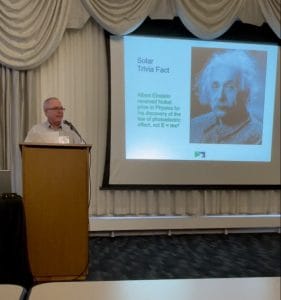The City Engineers Association of Minnesota (CEAM) held its annual conference on January 26-28, 2021, where industry professionals gather to network and learn about issues facing Minnesota cities, new technologies, innovative construction projects, and more. The three-day event welcomed over five hundred attendees, and hosted educational presentations on many topics, including solar energy.
Solar energy topics are gaining momentum with many municipalities considering solar power for their projects. Cedar Creek Energy had the opportunity to present at the conference alongside the City of St. Cloud and Barr Engineering Company on solar topics. Tracy Hodel from the City of St. Cloud explained how the city implemented solar over time and offered insights to other cities in attendance. Carlos Ballinas of Barr Engineering presented other information to consider when looking at solar projects, and finally, Cedar Creek Energy’s own Senior Project Engineer Rick Tisdale offered expertise to cities on how to make their solar projects more successful.
Cedar Creek has completed over 500 commercial solar projects, including Minnesota’s largest solar project to date; an installation of over 2 megawatts in Brooklyn Park. Other large projects include the City of Becker Wastewater plant (700kW) and the City of Eden Prairie (over 1 megawatt).
Rick explained that perhaps the most important key to a successful solar project is to understand the rules set by the utility company in the project area, as these will directly affect the proper design of a solar project. For cities that have their own utility company, the agreement between the city and their power source may play a factor in the size of solar installation possible.
Project goals must also be clear, especially as cost savings are often a huge factor in planning city projects. Many cities can offset 100% of their consumption with renewable energy. Based on the load profile at the wastewater treatment center in the City of Becker, Cedar Creek Energy utilized a single axis tracker to maximize their incentive from the utility company. Facility load profile and available roof or ground space are key factors to the design.

The most important takeaway from Rick’s presentation is the encouragement for municipalities begin looking at solar for their projects NOW. The Federal Tax Credit that offers a 26% reduction in price for new solar installations will decrease from 26% to 22% in 2023 for commercial builds, which amounts to thousands of dollars in savings. Additionally, city projects are large scale, and their planning and construction naturally take time. Considering manufacturing inflation and utility costs on the rise, getting started with solar today will be more cost effective than waiting.
Rick answered a Q&A from many municipal professionals and discussed new projects with interested cities after his presentation. Cedar Creek Energy looks forward to working with more cities in the future. With the importance of acting on solar before its too late, call us today to get started!

